

Compact Muon Solenoid
LHC, CERN
| CMS-HIN-15-006 ; CERN-EP-2016-105 | ||
| Multiplicity and rapidity dependence of strange hadron production in pp, pPb, and PbPb collisions at the LHC | ||
| CMS Collaboration | ||
| 22 May 2016 | ||
| Phys. Lett. B 768 (2017) 103 | ||
| Abstract: Measurements of strange hadron ($\mathrm{K_S}^0$, $\Lambda$+$\overline{\Lambda}$, and $\Xi^+$+$\Xi^-$) transverse momentum spectra in pp, pPb, and PbPb collisions are presented over a wide range of rapidity and event charged-particle multiplicity. The data were collected with the CMS detector at the CERN LHC in pp collisions at $\sqrt{s} = $ 7 TeV, pPb collisions at $\sqrt{s_{\mathrm{NN}}} = $ 5.02 TeV, and PbPb collisions at $\sqrt{s_{\mathrm{NN}}} = $ 2.76 TeV. The average transverse kinetic energy is found to increase with multiplicity, at a faster rate for heavier strange particle species in all systems. At similar multiplicities, the difference in average transverse kinetic energy between different particle species is observed to be larger for pp and pPb events than for PbPb events. In pPb collisions, the average transverse kinetic energy is found to be slightly larger in the Pb-going direction than in the p-going direction for events with large multiplicity. The spectra are compared to models motivated by hydrodynamics. | ||
| Links: e-print arXiv:1605.06699 [hep-ex] (PDF) ; CDS record ; inSPIRE record ; HepData record ; CADI line (restricted) ; | ||
| Figures & Tables | Summary | Additional Figures | References | CMS Publications |
|---|
| Figures | |

png pdf |
Figure 1:
Invariant mass distribution of $\mathrm{ K_S }^0$ (left), $\Lambda$ (middle), and $\Xi^-$ (right) candidates in the ${p_{\mathrm {T}}}$ range 1-3 GeV for 220 $ \leq {N_\text {trk}^\text {offline}} < $ 260 in pPb collisions. The solid lines show the results of fits described in the text. The dashed lines indicate the fitted background component. |
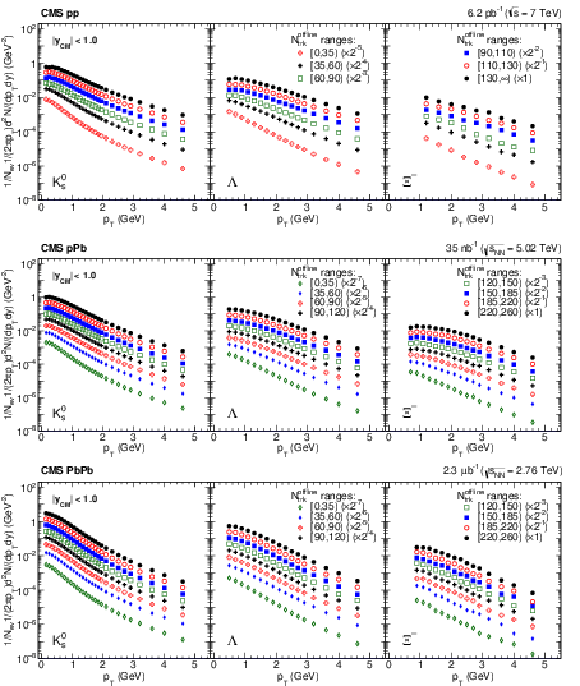
png pdf |
Figure 2:
The ${p_{\mathrm {T}}}$ spectra of $\mathrm{ K_S }^0$, $\Lambda$ , and $\Xi^-$ \ particles in the center-of-mass rapidity range $ {| y_\text {cm} | } < $ 1 in pp collisions at $ {\sqrt {s}} = $ 7 TeV (a), pPb collisions at $ {\sqrt {s}} = $ 5.02 TeV (b), and PbPb collisions at $ {\sqrt {s_{_{_{\mathrm{NN}}}}}} = $ 2.76 TeV (c) for different multiplicity intervals. The data in the different multiplicity intervals are scaled by factors of $2^{-n}$ for better visibility. |

png pdf |
Figure 2-a:
The ${p_{\mathrm {T}}}$ spectra of $\mathrm{ K_S }^0$, $\Lambda$ , and $\Xi^-$ \ particles in the center-of-mass rapidity range $ {| y_\text {cm} | } < $ 1 in pp collisions at $ {\sqrt {s}} = $ 7 TeV (a), pPb collisions at $ {\sqrt {s}} = $ 5.02 TeV (b), and PbPb collisions at $ {\sqrt {s_{_{_{\mathrm{NN}}}}}} = $ 2.76 TeV (c) for different multiplicity intervals. The data in the different multiplicity intervals are scaled by factors of $2^{-n}$ for better visibility. |
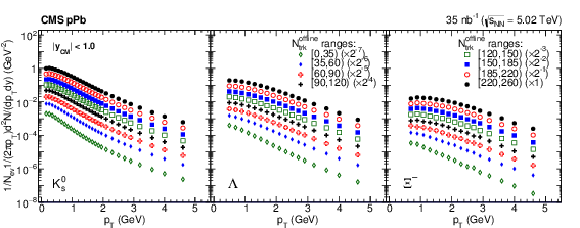
png pdf |
Figure 2-b:
The ${p_{\mathrm {T}}}$ spectra of $\mathrm{ K_S }^0$, $\Lambda$ , and $\Xi^-$ \ particles in the center-of-mass rapidity range $ {| y_\text {cm} | } < $ 1 in pp collisions at $ {\sqrt {s}} = $ 7 TeV (a), pPb collisions at $ {\sqrt {s}} = $ 5.02 TeV (b), and PbPb collisions at $ {\sqrt {s_{_{_{\mathrm{NN}}}}}} = $ 2.76 TeV (c) for different multiplicity intervals. The data in the different multiplicity intervals are scaled by factors of $2^{-n}$ for better visibility. |
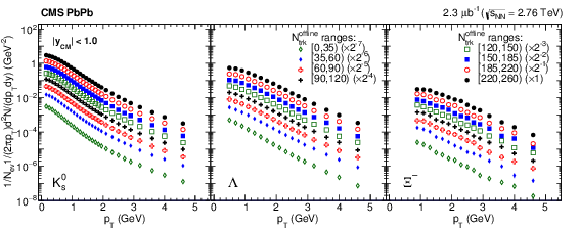
png pdf |
Figure 2-c:
The ${p_{\mathrm {T}}}$ spectra of $\mathrm{ K_S }^0$, $\Lambda$ , and $\Xi^-$ \ particles in the center-of-mass rapidity range $ {| y_\text {cm} | } < $ 1 in pp collisions at $ {\sqrt {s}} = $ 7 TeV (a), pPb collisions at $ {\sqrt {s}} = $ 5.02 TeV (b), and PbPb collisions at $ {\sqrt {s_{_{_{\mathrm{NN}}}}}} = $ 2.76 TeV (c) for different multiplicity intervals. The data in the different multiplicity intervals are scaled by factors of $2^{-n}$ for better visibility. |

png pdf |
Figure 3:
Ratios of ${p_{\mathrm {T}}}$ spectra for $\Lambda /\mathrm{ K_S }^0$ (a) and $\Xi^- /\Lambda$ (b) in the center-of-mass rapidity range $ {| y_\text {cm} | } < $ 1.0 for pp collisions at $ {\sqrt {s}} = $ 7 TeV (left), pPb collisions at $ {\sqrt {s}} = $ 5.02 TeV (middle), and PbPb collisions at $ {\sqrt {s_{_{_{\mathrm{NN}}}}}} = $ 2.76 TeV\ (right). Two (for pp ) or three (for pPb and PbPb ) representative multiplicity intervals are presented. The error bars represent the statistical uncertainties, while the boxes indicate the systematic uncertainties. |
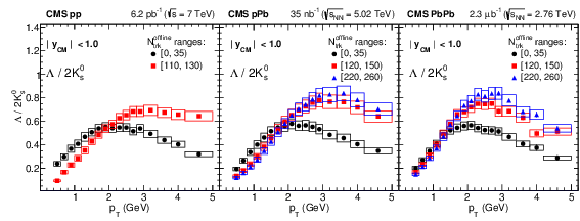
png pdf |
Figure 3-a:
Ratios of ${p_{\mathrm {T}}}$ spectra for $\Lambda /\mathrm{ K_S }^0$ (a) and $\Xi^- /\Lambda$ (b) in the center-of-mass rapidity range $ {| y_\text {cm} | } < $ 1.0 for pp collisions at $ {\sqrt {s}} = $ 7 TeV (left), pPb collisions at $ {\sqrt {s}} = $ 5.02 TeV (middle), and PbPb collisions at $ {\sqrt {s_{_{_{\mathrm{NN}}}}}} = $ 2.76 TeV\ (right). Two (for pp ) or three (for pPb and PbPb ) representative multiplicity intervals are presented. The error bars represent the statistical uncertainties, while the boxes indicate the systematic uncertainties. |

png pdf |
Figure 3-b:
Ratios of ${p_{\mathrm {T}}}$ spectra for $\Lambda /\mathrm{ K_S }^0$ (a) and $\Xi^- /\Lambda$ (b) in the center-of-mass rapidity range $ {| y_\text {cm} | } < $ 1.0 for pp collisions at $ {\sqrt {s}} = $ 7 TeV (left), pPb collisions at $ {\sqrt {s}} = $ 5.02 TeV (middle), and PbPb collisions at $ {\sqrt {s_{_{_{\mathrm{NN}}}}}} = $ 2.76 TeV\ (right). Two (for pp ) or three (for pPb and PbPb ) representative multiplicity intervals are presented. The error bars represent the statistical uncertainties, while the boxes indicate the systematic uncertainties. |

png pdf |
Figure 4:
The extracted kinetic freeze-out temperature, $T_\text {kin}$, versus the average radial-flow velocity, $< \beta _\mathrm {T} > $, from a simultaneous blast-wave fit to the $\mathrm{ K_S }^0$ and $\Lambda$ \ ${p_{\mathrm {T}}}$ spectra at $ {| y_\text {cm} | } < $ 1 for different multiplicity intervals in pp , pPb , and PbPb collisions. The six pp and eight pPb and PbPb multiplicity intervals are indicated in the legend of Fig. 2. For the results in this plot, the multiplicity increases from left to right. The correlation ellipses represent the statistical uncertainties. Systematic uncertainties, which are evaluated to be on the order of a few percent, are not shown. |
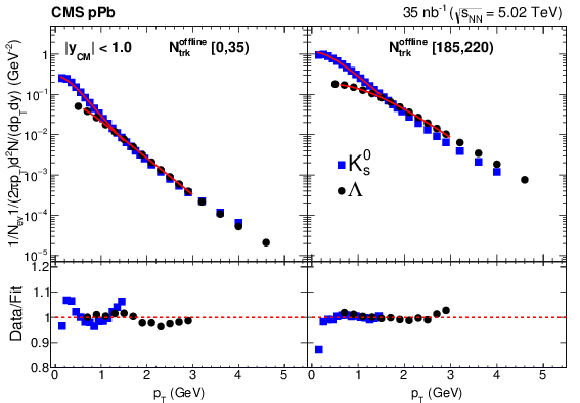
png pdf |
Figure 5:
Examples of simultaneous blast-wave fits of the ${p_{\mathrm {T}}}$ spectra of $\mathrm{ K_S }^0$ and $\Lambda$ \ particles in low- and high-multiplicity pPb events. The ratios of the fits to the data as a function of ${p_{\mathrm {T}}}$ are shown in the bottom panels. The uncertainties are statistical only and are too small to be visible for most of the points. |
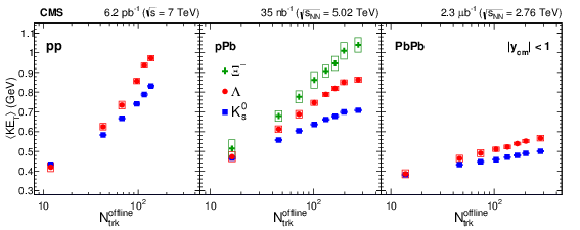
png pdf |
Figure 6:
The average transverse kinetic energy, $ {< \mathrm {KE}^\mathrm {T}}> $, at $ {| y_\text {cm} | }< $ 1 for $\mathrm{ K_S }^0$, $\Lambda$ , and $\Xi^-$ particles as a function of multiplicity in pp, pPb, and PbPb collisions. For the $\Xi^-$ , only results from pPb collisions are shown. The error bars represent the statistical uncertainties, while the boxes indicate the systematic uncertainties. |
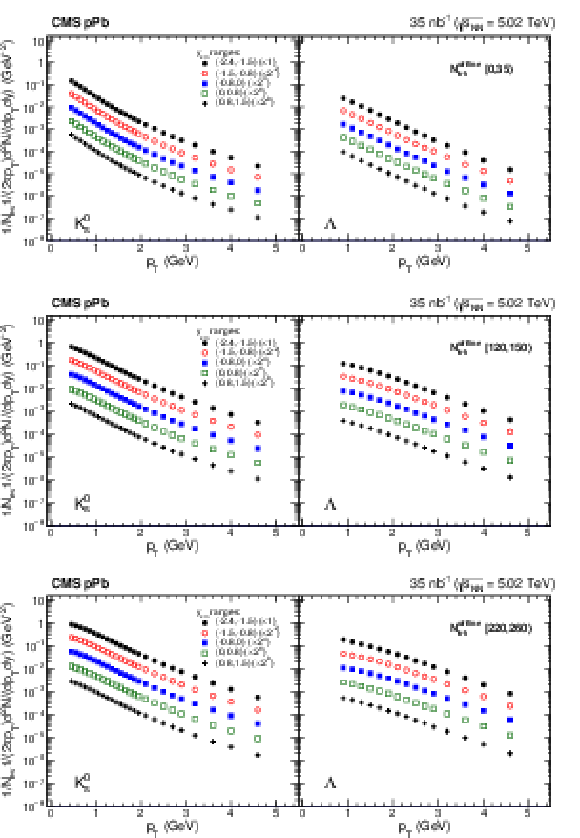
png pdf |
Figure 7:
The ${p_{\mathrm {T}}}$ spectra of $\mathrm{ K_S }^0$ and $\Lambda$ particles in different $y_\text {cm}$ ranges for pPb collisions at $ {\sqrt {s}} = $ 5.02 TeV. Results are shown for three multiplicity ranges: 0 $ \leq {N_\text {trk}^\text {offline}} < $ 35 (a), 120 $ \leq {N_\text {trk}^\text {offline}} < $ 150 (b), and 220 $ \leq {N_\text {trk}^\text {offline}} < $ 260 (c). Within each panel, the curves on top represent Pb-going events and the curves on bottom p-going events. The data in the different rapidity intervals are scaled by factors of $2^{-2n}$ for better visibility. |

png pdf |
Figure 7-a:
The ${p_{\mathrm {T}}}$ spectra of $\mathrm{ K_S }^0$ and $\Lambda$ particles in different $y_\text {cm}$ ranges for pPb collisions at $ {\sqrt {s}} = $ 5.02 TeV. Results are shown for three multiplicity ranges: 0 $ \leq {N_\text {trk}^\text {offline}} < $ 35 (a), 120 $ \leq {N_\text {trk}^\text {offline}} < $ 150 (b), and 220 $ \leq {N_\text {trk}^\text {offline}} < $ 260 (c). Within each panel, the curves on top represent Pb-going events and the curves on bottom p-going events. The data in the different rapidity intervals are scaled by factors of $2^{-2n}$ for better visibility. |
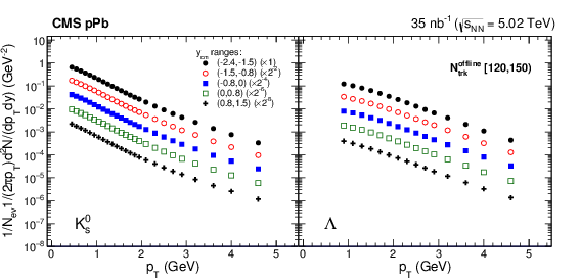
png pdf |
Figure 7-b:
The ${p_{\mathrm {T}}}$ spectra of $\mathrm{ K_S }^0$ and $\Lambda$ particles in different $y_\text {cm}$ ranges for pPb collisions at $ {\sqrt {s}} = $ 5.02 TeV. Results are shown for three multiplicity ranges: 0 $ \leq {N_\text {trk}^\text {offline}} < $ 35 (a), 120 $ \leq {N_\text {trk}^\text {offline}} < $ 150 (b), and 220 $ \leq {N_\text {trk}^\text {offline}} < $ 260 (c). Within each panel, the curves on top represent Pb-going events and the curves on bottom p-going events. The data in the different rapidity intervals are scaled by factors of $2^{-2n}$ for better visibility. |
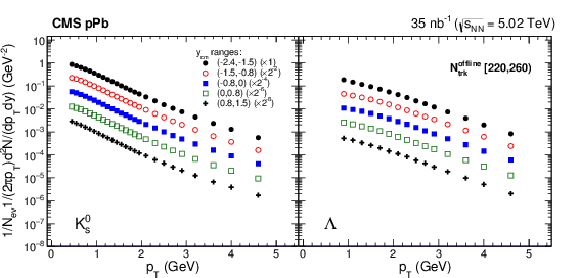
png pdf |
Figure 7-c:
The ${p_{\mathrm {T}}}$ spectra of $\mathrm{ K_S }^0$ and $\Lambda$ particles in different $y_\text {cm}$ ranges for pPb collisions at $ {\sqrt {s}} = $ 5.02 TeV. Results are shown for three multiplicity ranges: 0 $ \leq {N_\text {trk}^\text {offline}} < $ 35 (a), 120 $ \leq {N_\text {trk}^\text {offline}} < $ 150 (b), and 220 $ \leq {N_\text {trk}^\text {offline}} < $ 260 (c). Within each panel, the curves on top represent Pb-going events and the curves on bottom p-going events. The data in the different rapidity intervals are scaled by factors of $2^{-2n}$ for better visibility. |

png pdf |
Figure 8:
Ratios of ${p_{\mathrm {T}}}$ spectra, $\Lambda /\mathrm{ K_S }^0$, from the -1.5 $< y_\text {cm} <$ -0.8 (Pb-going) and 0.8 $ < y_\text {cm} < $ 1.5 (p-going) rapidity regions in pPb collisions at $ {\sqrt {s}} = $ 5.02 TeV. Results are presented for two multiplicity ranges 0 $ \leq {N_\text {trk}^\text {offline}} < $ 35 (left) and 220 $ \leq {N_\text {trk}^\text {offline}} < $ 260 (right). The error bars represent the statistical uncertainties, while the boxes indicate the systematic uncertainties. |

png pdf |
Figure 9:
The average transverse kinetic energy, $ {< \mathrm {KE}^\mathrm {T}}> $, as a function of $y_\text {cm}$ for the $\mathrm{ K_S }^0$ and $\Lambda$ particles in three ranges of multiplicity in pPb collisions at $ {\sqrt {s}} = $ 5.02 TeV. The error bars represent the statistical uncertainties, while the boxes indicate the systematic uncertainties. |
| Tables | |

png pdf |
Table 1:
Fraction of the full event sample in each multiplicity interval and the average multiplicity per interval for pp data. The multiplicities $N_\text {trk}^\text {offline}$ and $N_\text {trk}^\text {corrected}$ are determined for $ {| \eta | }< $ 2.4 and $ {p_{\mathrm {T}}} > $ 0.4 GeV before and after efficiency corrections, respectively. The third and fourth columns list the average values of $N_\text {trk}^\text {offline}$ and $N_\text {trk}^\text {corrected}$. |

png pdf |
Table 2:
Summary of systematic uncertainties for the ${p_{\mathrm {T}}}$ spectra of $\mathrm{ K_S }^0$, $\Lambda$, and $\Xi^-$ \ particles in the center-of-mass rapidity range $ {| y_\text {cm} | } < $ 1.0 (for pPb events, at forward rapidities, if different) for the three collision systems. |
| Summary |
| Measurements of strange hadron ($\mathrm{K_S}^0$, $\Lambda$+$\overline{\Lambda}$, and $\Xi^+$+$\Xi^-$) transverse momentum spectra in pp, pPb, and PbPb collisions are presented over a wide range of event charged-particle multiplicity and particle rapidity. The study is based on samples of pp collisions at $\sqrt{s} = $ 7 TeV, pPb collisions at $\sqrt{s} = $ 5.02 TeV, and PbPb collisions at $\sqrt{s_{\mathrm{NN}}} = $ 2.76 TeV, collected with the CMS detector at the LHC. In the context of hydrodynamic models, the measured particle spectra are fitted to a blast wave function, which describes an expanding fluid-like system. When comparing at a similar multiplicity, the extracted radial-flow velocity parameters are found to be larger in pp and pPb collisions than that in PbPb collisions. The average transverse kinetic energy ${<\mathrm{KE}^\mathrm{T}}> $ of strange hadrons is observed to increase with multiplicity, with a stronger increase for heavier particles. At similar multiplicities, the difference in ${<\mathrm{KE}^\mathrm{T}}> $ between the strange-particle species is larger in the smaller pp and pPb systems than in the PbPb system. For pPb collisions, ${<\mathrm{KE}^\mathrm{T}}> $ in the Pb-going direction for $\mathrm{K_S}^0$ ($\Lambda$+$\overline{\Lambda}$) is 6% (12%) larger than in the p-going direction for events with the highest particle multiplicities. |
| Additional Figures | |

png pdf |
Additional Figure 1:
The difference in $ {< \mathrm {KE}^\mathrm {T}}> $, between $\Lambda $ and $\mathrm{ K_S}^{0} $ has been presented as a function of multiplicity in pp, pPb, and PbPb collisions. The statistical uncertainty is invisible in the current scale, while the systematic uncertainty is represented by the box. |
| References | ||||
| 1 | E. Andersen et al. | Enhancement of central $ \Lambda $, $ \Xi $ and $ \Omega $ yields in Pb-Pb collisions at 158 A GeV/$ c $ | PLB 433 (1998) 209 | |
| 2 | STAR Collaboration | Experimental and theoretical challenges in the search for the quark gluon plasma: The STAR Collaboration's critical assessment of the evidence from RHIC collisions | NP A 757 (2005) 102 | nucl-ex/0501009 |
| 3 | J. Rafelski and B. Muller | Strangeness production in the quark-gluon plasma | PRL 48 (1982) 1066 | |
| 4 | STAR Collaboration | Enhanced strange baryon production in Au + Au collisions compared to p + p at s(NN)**(1/2) = 200-GeV | PRC 77 (2008) 044908 | 0705.2511 |
| 5 | WA97 Collaboration | Strangeness enhancement at mid-rapidity in Pb Pb collisions at 158-A-GeV/c | PLB 449 (1999) 401 | |
| 6 | STAR Collaboration | Multistrange baryon production in Au-Au collisions at S(NN)**1/2 = 130 GeV | PRL 92 (2004) 182301 | nucl-ex/0307024 |
| 7 | PHENIX Collaboration | Formation of dense partonic matter in relativistic nucleus-nucleus collisions at RHIC: Experimental evaluation by the PHENIX Collaboration | NP A 757 (2005) 184 | nucl-ex/0410003 |
| 8 | CMS Collaboration | Observation of long-range near-side angular correlations in proton-proton collisions at the LHC | JHEP 09 (2010) 091 | CMS-QCD-10-002 1009.4122 |
| 9 | CMS Collaboration | Observation of long-range, near-side angular correlations in pPb collisions at the LHC | PLB 718 (2013) 795 | CMS-HIN-12-015 1210.5482 |
| 10 | ATLAS Collaboration | Observation of associated near-side and away-side long-range correlations in $ \sqrt{s_{\mathrm{NN}}} = $ 5.02 TeV proton-lead collisions with the ATLAS detector | PRL 110 (2013) 182302 | 1212.5198 |
| 11 | ALICE Collaboration | Long-range angular correlations on the near and away side in $ \mathrm{ p Pb }\ $ collisions at $ \sqrt{s_{\mathrm{NN}}} = $ 5.02 TeV | PLB 719 (2013) 29 | 1212.2001 |
| 12 | K. Dusling, W. Li, and B. Schenke | Novel collective phenomena in high-energy proton-proton and proton-nucleus collisions | Int. J. Mod. Phys. E 25 (2016), no. 01, 1630002 | 1509.07939 |
| 13 | P. Bozek | Collective flow in $ p $-Pb and $ d $-Pb collisions at TeV energies | PRC 85 (2012) 014911 | 1112.0915 |
| 14 | P. Bozek and W. Broniowski | Correlations from hydrodynamic flow in $ \mathrm{ p Pb }\ $ collisions | PLB 718 (2013) 1557 | 1211.0845 |
| 15 | A. Bzdak, B. Schenke, P. Tribedy, and R. Venugopalan | Initial state geometry and the role of hydrodynamics in proton-proton, proton-nucleus and deuteron-nucleus collisions | PRC 87 (2013) 064906 | 1304.3403 |
| 16 | K. Werner, I. Karpenko, and T. Pierog | ``ridge'' in proton-proton scattering at 7 TeV | PRL 106 (2011) 122004 | 1011.0375 |
| 17 | K. Dusling and R. Venugopalan | Explanation of systematics of CMS p+Pb high multiplicity di-hadron data at $ \sqrt{s_{\mathrm{NN}}} = $ 5.02 TeV | PRD 87 (2013) 054014 | 1211.3701 |
| 18 | K. Dusling and R. Venugopalan | Evidence for BFKL and saturation dynamics from dihadron spectra at the LHC | PRD 87 (2013) 051502 | 1210.3890 |
| 19 | A. Dumitru, L. McLerran, and V. Skokov | Azimuthal asymmetries and the emergence of ``collectivity'' from multi-particle correlations in high-energy pA collisions | PLB 743 (2015) 134 | 1410.4844 |
| 20 | M. Gyulassy, P. Levai, I. Vitev, and T. S. Biro | Non-Abelian bremsstrahlung and azimuthal asymmetries in high energy $ p+A $ reactions | PRD 90 (2014) 054025 | 1405.7825 |
| 21 | W. Li | Observation of a 'ridge' correlation structure in high multiplicity proton-proton collisions: A brief review | MPLA 27 (2012) 1230018 | 1206.0148 |
| 22 | L. He et al. | Anisotropic parton escape is the dominant source of azimuthal anisotropy in transport models | PLB 753 (2016) 506 | 1502.05572 |
| 23 | ALICE Collaboration | Centrality dependence of $ \pi $, $ K $, $ p $ production in Pb-Pb collisions at $ \sqrt{s_{\mathrm{NN}}} = $ 2.76 TeV | PRC 88 (2013) 044910 | 1303.0737 |
| 24 | ALICE Collaboration | Elliptic flow of identified hadrons in Pb-Pb collisions at $ \sqrt{s_{\mathrm{NN}}}= $ 2.76 TeV | JHEP 06 (2015) 190 | 1405.4632 |
| 25 | H. Song, S. Bass, and U. W. Heinz | Spectra and elliptic flow for identified hadrons in 2.76A TeV Pb+Pb collisions | PRC 89 (2014) 034919 | 1311.0157 |
| 26 | X. Zhu, F. Meng, H. Song, and Y.-X. Liu | Hybrid model approach for strange and multistrange hadrons in 2.76A TeV Pb+Pb collisions | PRC 91 (2015), no. 3, 034904 | 1501.03286 |
| 27 | ALICE Collaboration | Multiplicity dependence of pion, kaon, proton and lambda production in p-pb collisions at $ \sqrt{s_{\mathrm{NN}}} = $ 5.02 TeV | PLB 728 (2014) 25 | 1307.6796 |
| 28 | CMS Collaboration | Study of the production of charged pions, kaons, and protons in pPb collisions at $ \sqrt{s_{\mathrm{NN}}} = $ 5.02 TeV | EPJC 74 (2014) 2847 | CMS-HIN-12-016 1307.3442 |
| 29 | ALICE Collaboration | Long-range angular correlations of $ \pi $, K and p in p--Pb collisions at $ \sqrt{s_{\mathrm{NN}}} = $ 5.02 TeV | PLB 726 (2013) 164 | 1307.3237 |
| 30 | CMS Collaboration | Long-range two-particle correlations of strange hadrons with charged particles in pPb and PbPb collisions at LHC energies | PLB 742 (2015) 200 | CMS-HIN-14-002 1409.3392 |
| 31 | E. Shuryak and I. Zahed | High-multiplicity $ pp $ and $ pA $ collisions: Hydrodynamics at its edge | PRC 88 (2013) 044915 | 1301.4470 |
| 32 | E. Schnedermann, J. Sollfrank, and U. Heinz | Thermal phenomenology of hadrons from 200 $ A $ GeV S+S collisions | PRC 48 (1993) 2462 | nucl-th/9307020 |
| 33 | UA1 Collaboration | A study of the general characteristics of proton-antiproton collisions at $ \sqrt{s} = $ 0.2 TeV to 0.9 TeV | NPB 335 (1990) 261 | |
| 34 | T. Alexopoulos et al. | Multiplicity dependence of the transverse momentum spectrum for centrally produced hadrons in antiproton-proton collisions at $ \sqrt{s}= $ 1.8 Tev | PRL 60 (1988) 1622 | |
| 35 | STAR Collaboration | Systematic measurements of identified particle spectra in $ p p $, $ d+\mathrm{Au} $ and $ \mathrm{Au}+\mathrm{Au} $ collisions from STAR | PRC 79 (2009) 034909 | 0808.2041 |
| 36 | A. Ortiz Velasquez et al. | Color reconnection and flowlike patterns in $ pp $ collisions | PRL 111 (2013) 042001 | 1303.6326 |
| 37 | P. Bozek, A. Bzdak, and V. Skokov | The rapidity dependence of the average transverse momentum in p+Pb collisions at the LHC: the color glass condensate versus hydrodynamics | PLB 728 (2014) 662 | 1309.7358 |
| 38 | CMS Collaboration | Description and performance of track and primary-vertex reconstruction with the CMS tracker | JINST 9 (2014) P10009 | CMS-TRK-11-001 1405.6569 |
| 39 | CMS Collaboration | The CMS experiment at the CERN LHC | JINST 3 (2008) S08004 | CMS-00-001 |
| 40 | Geant4 Collaboration | Geant4: A simulation toolkit | Nucl. Instrum. and Methods A 506 (2003) 250 | |
| 41 | CMS Collaboration | Multiplicity and transverse momentum dependence of two- and four-particle correlations in $ \mathrm{ p Pb }\ $ and $ \mathrm{ Pp Pb }\ $ collisions | PLB 724 (2013) 213 | CMS-HIN-13-002 1305.0609 |
| 42 | CMS Collaboration | Azimuthal anisotropy of charged particles at high transverse momenta in PbPb collisions at $ \sqrt{s_{\mathrm{NN}}} = $ 2.76 TeV | PRL 109 (2012) 022301 | CMS-HIN-11-012 1204.1850 |
| 43 | CMS Trigger and Data Acquisition Group Collaboration | The CMS high level trigger | EPJC 46 (2006) 605 | hep-ex/0512077 |
| 44 | T. Pierog et al. | EPOS LHC: Test of collective hadronization with data measured at the CERN Large Hadron Collider | PRC 92 (2015) 034906 | |
| 45 | M. Gyulassy and X.-N. Wang | HIJING 1.0: A Monte Carlo program for parton and particle production in high-energy hadronic and nuclear collisions | CPC 83 (1994) 307 | nucl-th/9502021 |
| 46 | T. Sjostrand, S. Mrenna, and P. Skands | PYTHIA 6.4 physics and manual | JHEP 05 (2006) 026 | hep-ph/0603175 |
| 47 | T. Sjostrand, S. Mrenna, and P. Skands | A brief introduction to PYTHIA 8.1 | Comp. Phys. Comm. 178 (2008) 852 | 0710.3820 |
| 48 | CMS Collaboration | Measurement of tracking efficiency | CMS-PAS-TRK-10-002 | |
| 49 | CMS Collaboration | Strange particle production in pp collisions at $ \sqrt{s} = $ 0.9 and 7 TeV | JHEP 05 (2011) 064 | CMS-QCD-10-007 1102.4282 |
| 50 | Particle Data Group, K. A. Olive et al. | Review of Particle Physics | CPC 38 (2014) 090001 | |
| 51 | P. Bozek and I. Wyskiel-Piekarska | Particle spectra in Pb-Pb collisions at $ \sqrt{s_{\mathrm{NN}}} =\ $ 2.76 TeV | PRC 85 (2012) 064915 | 1203.6513 |
| 52 | I. A. Karpenko, \relax Yu. M. Sinyukov, and K. Werner | Uniform description of bulk observables in the hydrokinetic model of $ A+A $ collisions at the BNL Relativistic Heavy Ion Collider and the CERN Large Hadron Collider | PRC 87 (2013) 024914 | 1204.5351 |
| 53 | R. J. Fries, V. Greco, and P. Sorensen | Coalescence Models For Hadron Formation From Quark Gluon Plasma | Ann. Rev. Nucl. Part. Sci. 58 (2008) 177 | 0807.4939 |
| 54 | CMS Collaboration | Study of the inclusive production of charged pions, kaons, and protons in pp collisions at $ \sqrt{s}= $ 0.9 , 2.76, and 7 TeV | EPJC 72 (2012) 2164 | CMS-FSQ-12-014 1207.4724 |
| 55 | ALICE Collaboration | Production of K$ ^{*} $ (892)$ ^{0} $ and $ \phi $ (1020) in p-Pb collisions at $ \sqrt{s_{{\text {NN}}}} = $ 5.02 TeV | EPJC 76 (2016), no. 5, 245 | 1601.07868 |

|
Compact Muon Solenoid LHC, CERN |

|

|

|

|

|

|